M
Leave a Legacy of Giving
You can support our mission of changing lives by saving sight in multiple ways!
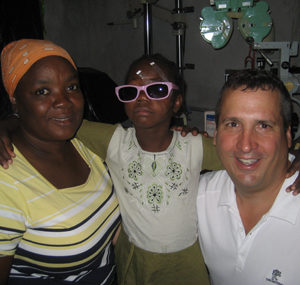

Dr. Andrew Moyes poses with 11 year-old Miriam who receive a second cornea transplant in 2011 with tissue provided by Saving Sight.
In a developing country like Haiti, vision loss can be a devastating blow to an individual’s ability to work and support one’s self, not to mention his or her entire family. Glaucoma, cataracts, corneal blindness – disorders that can be treated here in the U.S. – can sink a poor family into complete and desperate poverty. In Haiti, blindness can be lethal.
Yet, in the midst of this darkness, lies hope for thousands thanks to nonprofit organizations and mission groups as well as the dedicated volunteers who support them. Volunteers like our partner in sight, Dr. Andrew Moyes of Moyes Eye Center in Kansas City, MO, who has performed sight-saving surgeries on nine mission trips to Haiti, including corneal transplants using gratis donated tissue provided by Saving Sight.
An Ophthalmologist Discovers His Mission
When Dr. Moyes was first approached to donate his time at the Northwest Haiti Christian Mission (NWHCM), he made a financial contribution, but declined the invitation to Haiti. Soon after, as he watched a video on everything the Mission offered residents – the schools, feeding programs, birthing center, orphanages – he was moved to take his first Haitian mission trip.
In 2004, Dr. Moyes joined the surgical team at the NWHCM in the Northwest Zone of Haiti, the poorest state in the poorest country in the Western Hemisphere. On his first mission trip, Dr. Moyes and his fellow doctors performed 60 cataract surgeries; by his eighth trip in February 2011, that number grew to 162 performed in just four-and-a-half days.
In addition, the surgical team is trying to ease the devastating effects of glaucoma in the country. Said Dr. Moyes, “Glaucoma is so rampant in Haiti that one-fourth of people that we see in our clinic are blinded by the disease. Glaucoma isn’t even one of the World Health Organization’s priorities because it is so hard to treat.” However, through preventative eye exams, laser treatments to halt further vision loss, and glaucoma medications donated by Alcon and Allergan, the doctors are making headway.
“We’re trying to push back how quickly people go blind. Maybe Lord willing, someone will go blind in 12 years instead of two. When you see healthy 30 year-olds who want to work, but have no light perception because of glaucoma to perform a job, it’s enough to break your heart.”
Dr. Moyes also uses his expertise as a renowned corneal surgeon to save sight. In August 2011 for instance, he transplanted gratis tissue from the Eye Bank to restore vision to three individuals in need, including a 26 year-old male whose corneal scar affected his ability to work and an 18-year-old female who traveled from Port-au-Prince to this rural area of the country to save her vision.
But one transplant recipient who has stuck out in his mind is Miriam, an 11 year-old suffering from congenital hereditary endothelial dystrophy, a condition that thickens and clouds the cornea. Miriam received a corneal transplant in one eye two years ago – the result was so remarkable she was able to move from a special needs orphanage to one which provided her more independence. Because of a donor family’s incredible generosity here in the Midwest, Dr. Moyes was able to save her sight in her other eye, helping to provide her with a solid foundation for her future.
Continuing to Serve Both at Home and Overseas
The goal of these medical mission trips is not to perform the surgeries and walk away, but to truly help the Haitian people help themselves. Dr. Moyes and his colleagues are focused on teaching ophthalmologists in Haiti the skills they need to offer services throughout the year. In addition, because patient follow-up is so crucial after eye surgery, a Haitian ophthalmologist is available at NWHCM four days a month for follow-up exams and maintains contact with the medical team on any pertinent issues.
Even among the overwhelming circumstances – the backlog of patients, the country’s challenging infrastructure, the inability to help all who need assistance, Dr. Moyes finds hope and joy in the faces of those he’s helped. So much so that he has integrated his passion for the Haiti people into his professional life at Moyes Eye Center and into his personal life, now that his wife and four children often join him on mission trips.
“There’s not a day that goes by that I don’t think about what needs to be done, what we can do to make eye care better in Haiti. Seeing the joy in people’s faces when they realize they can see again brings such joy to my heart. As anyone on a mission trip will tell you – you go there to bring blessings to others, but you will be blessed a hundredfold by them. It feels so right to serve these people.”
We at the Eye Bank could not provide Dr. Moyes with gratis tissue for his mission trips without the compassion of donor families and the contributions of our generous financial supporters. To learn how you can pledge to give sight, whether around the world or in your own backyard, please visit our About Cornea Donation page.


Cate celebrates her daughter’s
wedding.
Where do I begin? So many people have contributed to my gift of vision this past year. They say it takes a community to raise a child. In my case, it took a community of compassionate professionals and individuals to provide me with the amazing gift of sight that I have to write this letter today.
I am a writer, both professionally as a grant writer and personally as a poet and story teller. I have had the pleasure of being published on multiple occasions and am proud when anyone takes the time to read my prose. My financial earnings support my family of three — myself, my elderly mother, and my daughter. I have been fortunate to be able to sustain our family with the proceeds of my written work. Seeing is everything to me.
When my vision began to fail in my right eye two years ago, it was a slow and mysterious process. I was by all respects a young woman of 50 with the eyesight of someone in their 70s. I went to one professional after another, trying to find the answers as to why this was happening. Multiple tests led to the resounding statement, “I / we don’t know why this is happening”. The “Why” part of the puzzle seemed to be the issue that stumped everyone that I had sought counsel. Everyone, that is, until I was referred to Dr. Joseph Tauber. He effectively determined the “Why” part of my condition and quickly moved to the “How” can we manage and improve the condition. The answer was a cornea transplant.
As February 2012 approached, I began preparing for the very necessary cornea transplant. Out of the blue, my left eye – my good eye began to show signs of illness. The pressure shot up to dangerous levels for no explainable reason. That is where the next big boulder dropped on me – glaucoma. Immediate surgery was required to save both eyes.
This is where multiple blessings and random acts of kindness appear on the path to full sightedness I have today. Hence, I begin the gratitude to so many people that have made this possible:
To: Dr. Michael Stiles who selflessly and without consideration to financial gains performed the surgeries installing two filtering systems that have controlled the glaucoma in both of my eyes and to Dr. Bret King who continues to monitor the systems with great honesty and compassion.
To: Dr. Joseph Tauber who has given both professionally and compassionately in a tireless effort to ensure I remain a sighted and productive individual.
And last, but certainly not least –
To: Heartland Lions Eye Banks (now known as Saving Sight) whose tissue donation had made my sight a reality. And to the family of the loved one who, during a time of great sorrow, demonstrated the selfless act of tissue donation. All the gifts and blessings that preceded my transplant would have been in vain, had it not been for your act of kindness. Your contribution has given me the most irreplaceable gift of all: sight. Equally, I am now an organ/tissue donor and promote donation at every opportunity presented.
Since my surgeries, I am maintaining a healthy level of sight and taking nothing for granted. I am back to driving without being in fear of the person who entered on what use to be my blind side. I see colors and hues so vividly, whereas before they were dull, lifeless, and quite undefined. I have continued to write and have written several funded grants that have given back to my community several fold. As I said earlier, “Seeing is everything to me” and I am so grateful and blessed to share my gift of sight with the world.
Blessings,
Cate


Yet, until recently, Marsha was struggling with reading herself – only her issue was due to her declining vision.
At age 19, Marsha was diagnosed with Fuchs’ dystrophy, a genetic condition in which the cornea progressively deteriorates. By the time she was in her late thirties, her treatment included a constant regimen of eye drops, ointments and appointments.
The Fuchs’ dystrophy continued to worsen – the thick inner layer of her corneas collected moisture during the night, leaving her vision incredibly cloudy each morning and making both driving and reading extremely difficult.
Finally, in 2008, Marsha underwent a cornea transplant on her left eye, and in 2012, on her right eye. Although she faced complications with her initial transplant, today her vision is “amazing.” She no longer faces vision cloudiness every morning of her life and can now participate in her favorite activities, including exercising, traveling to see her grandchildren, and reading, with crystal clear vision.
Said Marsha, “I think of my donor often when I realize I’m reading the morning paper with no problems or looking up a phone number. I live in a little town, so traveling to the city on a weekend and being able to go early and face the sunlight is such a blessing. There’s such a feeling of independence with this gift.”
Marsha’s transplant also brought a new friend into her life – in Spring 2012, she and her most recent donor’s twin sister began corresponding regularly about their experiences, giving Marsha more insights into the woman who gave her the gift of sight.
In addition, the correspondence letters touched yet another person when Marsha shared them with a colleague whose husband had been an organ donor. The two coworkers were able to see first-hand both sides of the donation journey and the impact it has on some many people’s lives.
To learn more about joining the donor registry in Kansas, visit our donor page or the Donate Life Kansas website.
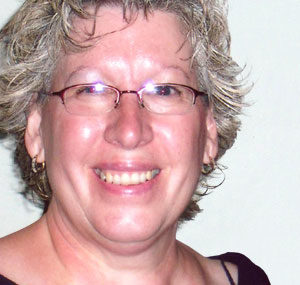

For years, Denise had suffered from the effects of the ocular herpes virus – a communicable virus many are exposed to early in childhood. When breakouts occurred, Denise was often left with scars all over her cornea, eventually causing her to become legally blind in her right eye.
The condition caused limitations in Denise’s life. “I wrote really big so I could see better,” she said. “And whenever I was walking, I would have to look down the whole time to see if the surface was flat. If I came to steps, I would look for something to hold on to with my right hand or hang on to somebody.”
Finally, in 2004, Denise underwent a cornea transplant. According to Denise, the transplant experience went smoothly – she had no pain during the surgery or the recovery. In fact, she was awake and alert during the entire surgery, and her husband even got to watch the procedure.
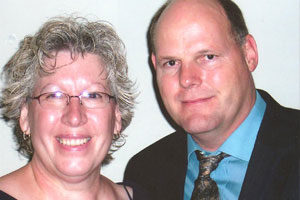
Today, Denise is back to reading again. She’s also taken up cross-stitching – a hobby she loved, but hadn’t been able to do in 20 years due to her limited vision. In addition, Denise is able to drive at night, something she couldn’t do prior to surgery, giving her more freedom and mobility in her day-to-day life.
Denise is a wonderful example of how a generous eye donor can change one’s life so dramatically. “I would certainly tell anyone – you are giving a gift through your donation. Becoming a donor is something you need to consider, and you should let your loved ones know what your thoughts are. It’s just the right thing to do.”


Larry is forever grateful to the donors
who gave the gift of sight to help him
see.
For years, Larry lived with the pain and inconvenience of an eye disease called keratoconus. The condition caused his corneas in both eyes to become cone shaped, leaving him with poor vision, constant headaches, eye pain and frequent eye infections.
The condition began to interfere with his daily activities. Larry had to depend on his “better” eye while at work. After work was done, he had to take his contacts out immediately, leaving him with virtually no vision during his time outside of work.
Eventually, Larry underwent two corneal transplant surgeries- one for each eye. Today, his vision is excellent- his vision has increased to 20/40 without glasses in both eyes. Larry is now able to live his life with total independence and has been able to get back to participating in all of his favorite hobbies that he had abandoned due to his poor vision.
Larry is forever grateful to the eye donors who gave the gift of sight to help him see. His donors’ families are always in his thoughts and he is grateful to them in helping to facilitate donation.
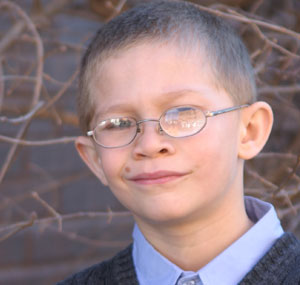
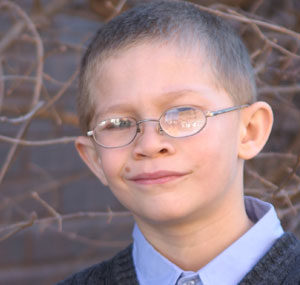
In April of 2003, five-year-old Kevin Lance of Skidmore, Missouri was rushed to the ER after a friend threw a stick that accidentally hit him in the eye. Kevin was immediately sent to Children’s Mercy in Kansas City where he had surgery to repair the corneal laceration. Although the laceration was repaired, the injury left a scar on Kevin’s cornea that blocked his vision.
The year that followed his initial surgery was very difficult as the doctor recommended patching Kevin’s good eye in order to strengthen the vision in the injured eye. Unfortunately, Kevin’s vision continued to deteriorate and his doctor decided that a cornea transplant was needed in order to save his sight. In June of 2004, Kevin, then six, received a cornea transplant.
A few days after the transplant Kevin accidentally ran into his sister while playing, causing one of his sutures to come loose. Due to the accident, Kevin was taken back into surgery the following day to repair the suture. Only a few weeks later, Kevin suffered another setback when his older brother accidentally hit him in the eye with his elbow. This injury caused Kevin more eye problems by rupturing his healing eye. Once again, Kevin went back into surgery where the doctor had to remove the lens of his eye.
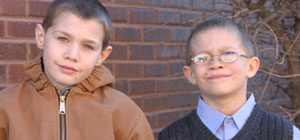
“Kevin has been a very brave little boy through all of this,” said Kevin’s mother, Rebecca. “There were times when I didn’t think I was going to be able to handle everything but after what Kevin has been through and to see how he has dealt with the situation has inspired me.”